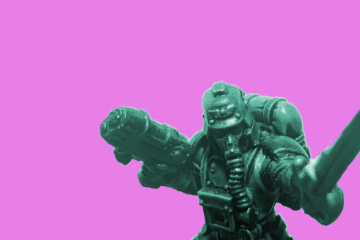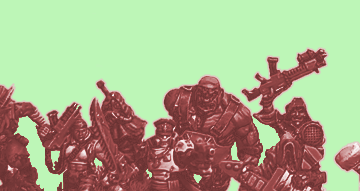Warhammer Underworlds: Direchasm, the fourth season of Games Workshop’s Warhammer Underworlds game, has been fully released for a month or so now (aside from an Arena Mortis expansion which was announced just after I’d written the first draft of this article), so I want to talk about how I’ve found the season as a whole.
For anyone who is not familiar with Warhammer Underworlds, it’s a hex based, competitive, two player strategy game. Each player picks a warband from the thirty-six that are available, and adds a deck of objective and power cards built from the large card pool. A game takes about half an hour to forty-five minutes to play. I’ve been playing Underworlds since it was first released in 2017. Prior to the pandemic I’d have described myself as a moderately competitive Underworlds player: I’ve played in a number of local store tournaments, and a few Grand Clashes (larger tournaments). My experience of Direchasm, however, has been quite different: I’ve been playing remotely via webcam, and for the most part playing only casual games, with the exception of one webcam tournament.

Painting Direchasm
Underworlds is one of the few Games Workshop games where players are not required to have painted model to participate in events, but painting is a big part of the hobby for me, and I’ve painted all thirty-five Underworlds warband I own (at the time of writing I don’t yet own the Storm of Celestus warband from the latest starter set).
The quality of the sculpts released for the eight Direchasm warbands has been one of the highlights of the season for me, I enjoyed painting all of them, and I don’t think there has been a single duff warband in terms of the model releases. One of my favourite things about Underworlds is that it gives you an opportunity to get a flavour of what painting the different Age of Sigmar factions is like without having to make a big investment in them. Initially I wasn’t hugely excited about the Direchasm starter set, because neither of the two warbands included, Lumineth Realm Lords and Slaanesh, are factions I’m drawn to in the Age of Sigmar universe. However, in the end, they both turned out to be interesting and enjoyable painting challenges that stretched my painting skills.
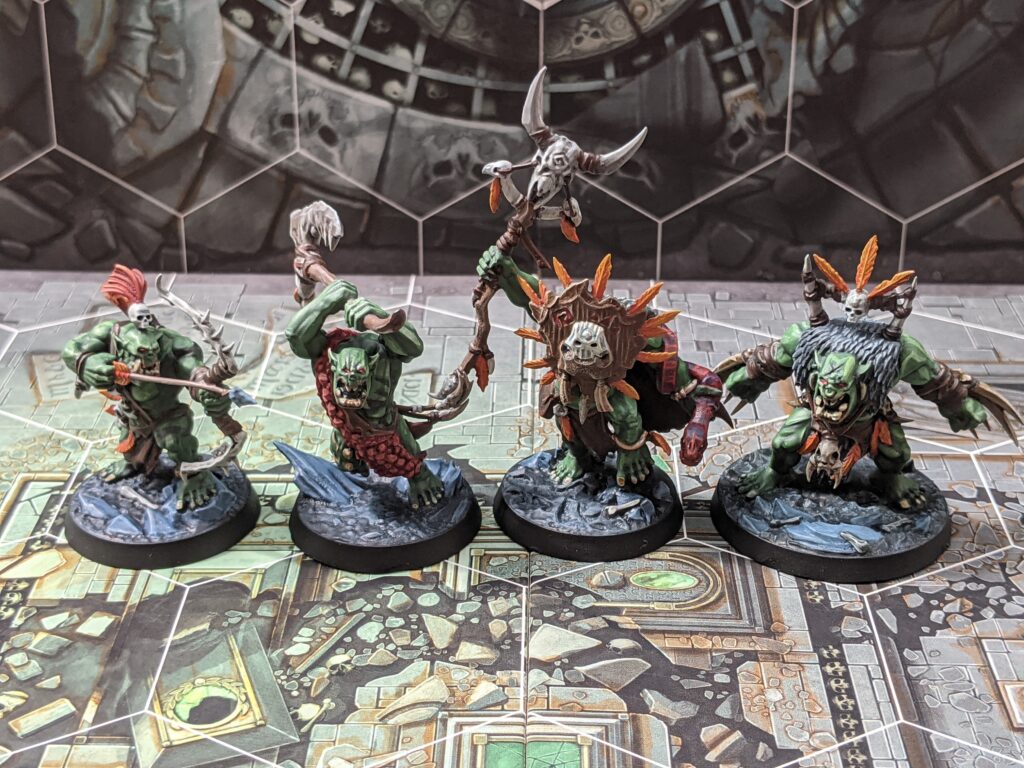
I’m going to rank the eight Direchasm warbands in order of how much I’ve enjoyed painting them:
8. The Starblood Stalkers: the Seraphon models are fantastic but my blue colour scheme didn’t work as well as I’d hoped. Probably the warband I’d most like to have another go at painting one day.
7. Hedkrakka’s Mad Mob: the Savage Orruks are probably my least favourite of the sculpts for the season (though they’re still lovely models), I struggled to think of anything interesting to do with them, so while I’m happy with my paint job they don’t stand out to me.
6. Elathain’s Soulraid: this warband was a real mixed bag for me. The crab and the fish were great fun to paint, the aelves less so – there was a lot of detail and I found them quite fiddly. I ended up using them as a test run for using Contrast paints over undershading, which I wanted to test before using it for another project. It worked ok, but some of the models ended up much better painted than others as I was learning as I went along.
5. Kainan’s Reapers: I absolutely love the sculpts for this warband, the models all have a ton of character, and I think the happy skeleton with a sword and shield might be my single favourite Direchasm model. I already have an Age of Sigmar Ossiarch Bonereaper army, so this was an easy painting project for me as I had a well-tested colour scheme already lined up.
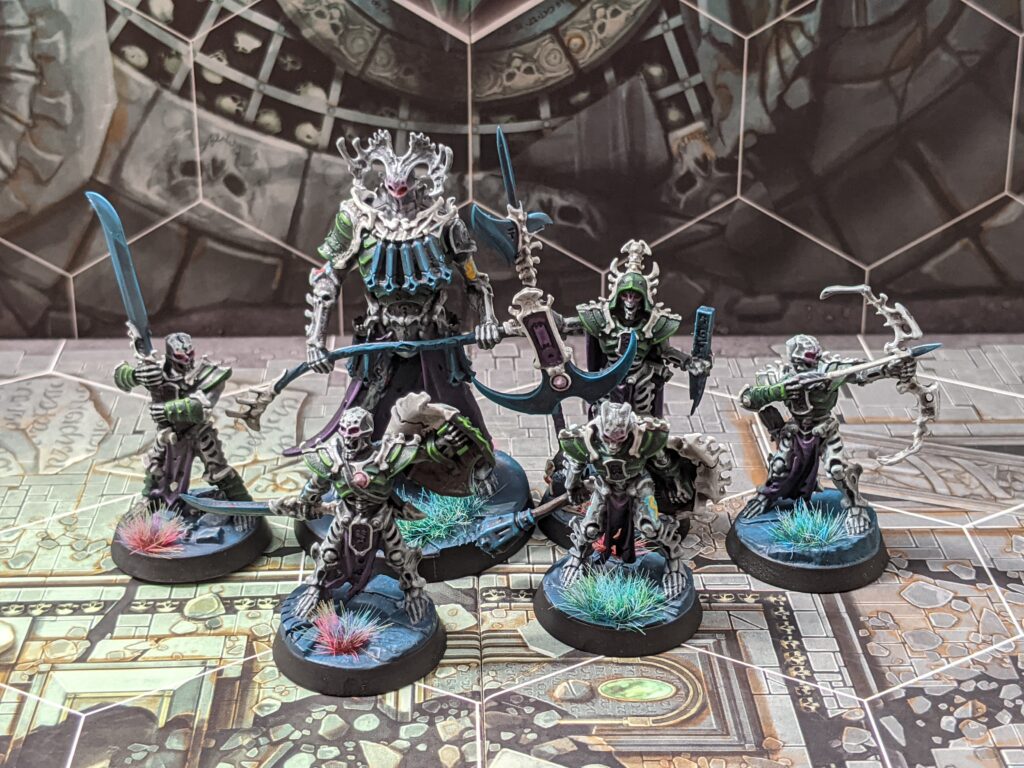
4. Myari’s Purifiers: I went into the Lumineth warband without much of a plan, but wanting to try out something different from my comfort zone of ‘base coat, shade, highlight’. I ended up using a lot of Contrast paints and glazing to get different shades of green, and I’m really pleased with how they came out.
3. The Crimson Court: the vampire models are all amazing, and were very enjoyable to paint. I went for a dark green colour scheme rather than the more traditional red, and am very happy with them.
2. The Dread Pageant: I normally like to pick my own colour scheme for a warband, but I was a bit intimidated by the Slaanesh models so I followed a tutorial by Mengel Miniatures. It was hard work, and these are probably the warband I spent the longest on, but I think they’ve ended up being my best painted warband of the season.
1. Khagra’s Ravagers: I love, love, love these Chaos Warrior models. They’re very reminiscent of classic Chaos Warriors, but with more dynamic poses and added character. I like how my colour scheme worked out, and they’re the warband I had the most fun painting.
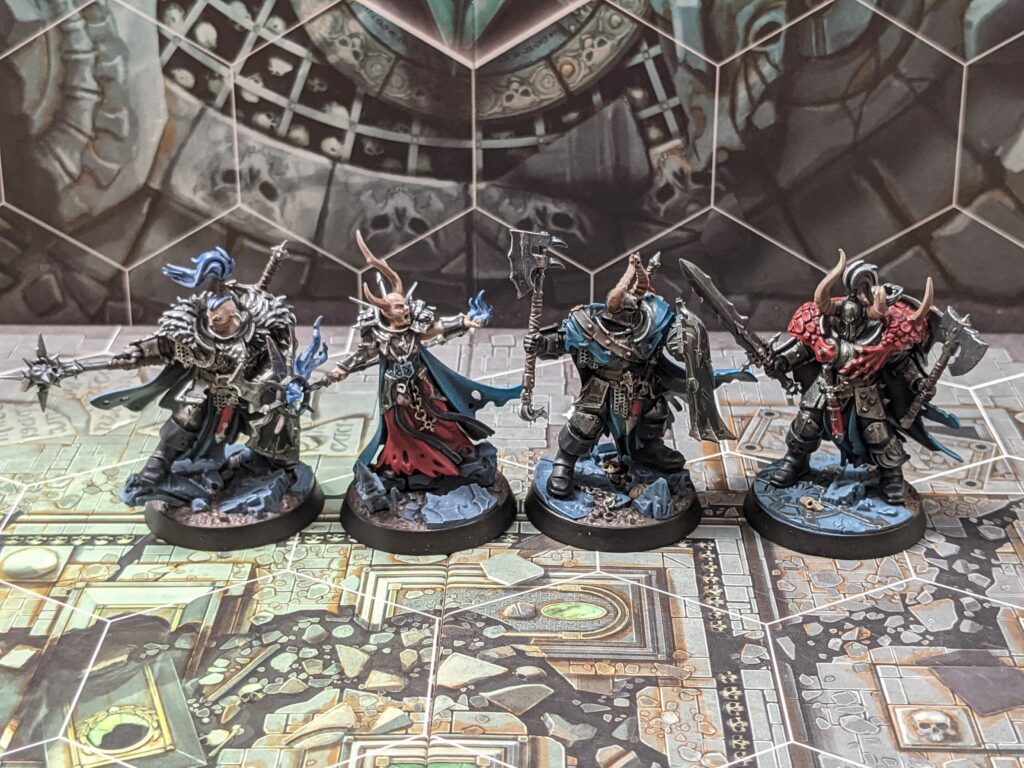
Playing Direchasm
Let’s address the elephant in the room first: my experience of playing Direchasm has been hugely impacted by the COVID-19 pandemic. I’ve yet to play a face to face game, and while I’ve played in one webcam tournament I don’t really feel I’ve got to grips with Direchasm competitively. I don’t have a strong sense of what the current competitive meta is, or which warbands are the strongest across the game as a whole at the moment. I’m not going to lie, I’ve really missed organised play, and I hope I’ll get a chance to go to a real life tournament before the next season comes out.
I’ve been disappointed by Games Workshop’s lack of support for the Underworlds community during the pandemic. I can understand that they don’t want to support gaming over Tabletop Simulator or other online platforms, but playing Underworlds over webcam with the real models and boards and dice is very feasible, and I feel that Games Workshop could have done more to support this. I’d have liked to see them provide advice on how to play over webcam, or provide some support and publicity to those community members who have organised informal webcam tournaments.
With that said, I’ve really enjoyed playing casual games of Direchasm. The Direchasm warbands all have their own unique mechanics or abilities, for example the Lumineth can spend ‘Aetherquartz’ tokens to reroll dice, and Khagra’s Ravagers can desecrate objectives so that they can’t be held. This definitely makes the game more complex, which does run the risk of being a barrier for new players; but as an experienced player I’ve enjoyed the depth it brings to the game. In previous seasons I’ve tended to focus on one or two warbands, but this season I’ve jumped around much more and given most of the warbands a go. The downside of that has been that I don’t feel I’ve got particularly good with any warband, so recently I’ve been playing mainly with the Crimson Court vampires to try to learn how to play them well.

I also like the Primacy mechanic that was introduced to the game this season. There are various ways you can gain the Primacy token, and if you hold it at the end of a round you get an extra glory point. It also interacts in interesting ways with some of the Direchasm cards. At one point I was worried that it might become too powerful, but from my experience so far it’s ended up in quite a good place, where it meaningfully impacts the game so that you have to think about it, but not to the extent of being overpowered.
I think the Direchasm card releases have for the most part been pretty good as well. The game suffered a bit in my view in the previous season from the emergence of a ‘Voltron’ competitive meta based around powering up a single fighter with powerful objectives, and that definitely carried over into this season too, though not to the same extent. However, the people in my regular gaming group haven’t tended to play that style very much, so I’ve not been too frustrated by it. Partway through the Direchasm season, Games Workshop released an ‘Essentials’ card pack, which brings back a number of popular cards from earlier seasons. I’m in two minds about whether this was a good thing: I think it helps make the game more accessible for new players, as they can buy a single card pack and get hold of a lot of useful cards that will help them build reasonably competitive decks without needing to buy every warband. However, there are some very good cards in the Essentials pack, and some of them edge out more interesting cards from the Direchasm season, which I don’t think is a good thing for the game.
There were definitely a few missteps in the Direchasm card releases, particularly Ferocious Resistance, a card that allowed powerful fighters to heal lots of wounds and made some warbands like Mollogs Mob extremely powerful. However, that card has now been banned (or ‘forsaken’, in Underworlds jargon). Overall, I think the card pool is in quite a good place since the latest update to the list of banned and restricted cards, and there are quite a few deck building options to play around with.
The pace of releases over this season was extremely fast, and I don’t really feel that I’ve got to grips with it yet, so I’m hoping we get a quiet few months now before the next season to give me a chance to try some different deck builds, try out those warbands I’ve not played with yet, and hopefully get a tournament or two in.

Here’s a ranking of how much I’ve enjoyed playing with those Direchasm warbands I’ve played with (the Starblood Stalkers, Kainan’s Reapers and Elathain’s Soulraid are still waiting for their first run out).
5. Myari’s Purifiers: they’re a strong warband, and they have some really interesting ploy cards, but I can’t bring myself to love elves.

4. Hedkrakka’s Madmob: I like the way they interact with the Primacy mechanic, but I did feel that it limited the deckbuilding opportunities for them since I had to fill a lot of the deck with Primacy related cards.
3. Khagra’s Ravagers: probably the weakest Direchasm warband competitively, but I enjoyed the challenge of figuring out how to make them (sort of) work.
2. The Crimson Court: there are quite a few ways to play the vampires, since you can choose to focus on either Inspiring your fighters or making them Bloodthirsty, different states which change their stats in different ways. They’re the warband I’ve played the most, and I’ve had fun with them, though more than most warbands I’ve found them to be very swingy depending on how good or bad my dice luck is.
1. The Dread Pageant: I like the mix of different fighter types in the Slaanesh warband, and they have some very strong and well themed ploy cards such as Shared Pain, which lets you pass damage around between fighters.
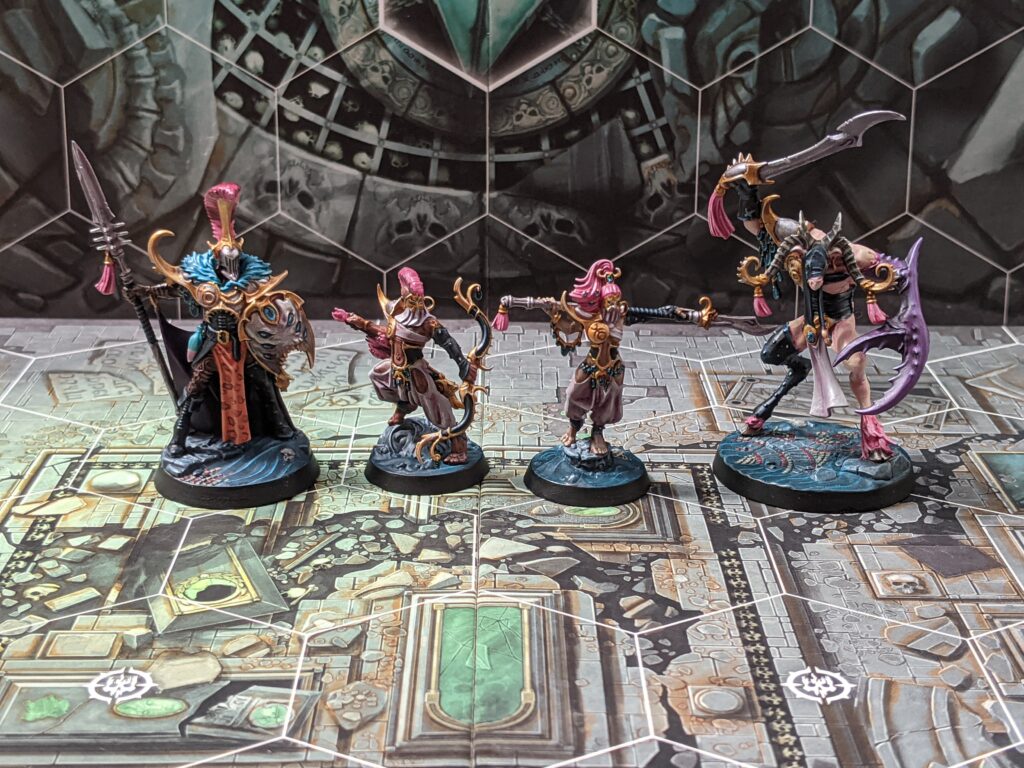
Final Thoughts
Overall, I’ve enjoyed Direchasm a lot. It’s been an odd season for the game with little to no organised play taking place, but I think the design space for the season has got into some interesting areas, and the warbands feel more unique than in previous seasons. One of the strengths of Underworlds has always been how well warband mechanics represent the lore of that warband, and that’s very much been the case this season, with for example the Idoneth Deepkin warband (elves who live in the sea) having mechanics themed around the flow of the tides. I do have a bit of a question mark over how much more design space there is left to explore for Underworlds. As yet, Games Workshop haven’t rotated out any of the older warbands, but I think perhaps we’re getting to a stage when the number of warbands is too big to be able to balance the game well, and it might be better if they rotated out the older ones (and perhaps looked for ways to re-release them with updated and more interesting rules). For the moment though, I’m looking forward to hopefully getting back to more competitive play before too long, and to seeing what the next season of the game brings.

